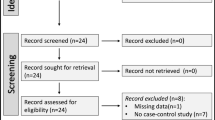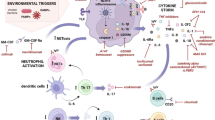Abstract
Macrophages may play a role in the pathogenesis of systemic sclerosis (SSc), and CD163-positive M2 macrophages are potentially important source for fibrosis-inducing cytokines. However, no link between M2 macrophages and SSc has been established. The aim is to evaluate the possibility that serum levels of soluble CD163 (sCD163) can be a useful marker for SSc, reflecting M2 activation of macrophages in this disease. Serum sCD163 levels of 43 patients with SSc, 10 patients with scleroderma spectrum disorder (SSD), and 12 healthy controls were measured with specific enzyme-linked immunosorbent assays. SSc patients had significantly higher serum sCD163 levels than healthy controls. The sCD163 levels in SSD patients were higher than healthy controls and lower than SSc patients. Significantly higher right ventricular systolic pressure and lower % DLco levels, and shorter duration of disease were seen in SSc patients with elevated serum sCD163 levels than those with normal levels. These results suggest that sCD163 levels may be increased in proportion to the progression of this disease, indicating the involvement of CD163 in the pathogenesis of SSc. Furthermore, serum sCD163 levels may be a marker of pulmonary hypertension at the early stage in patients with SSc.

Similar content being viewed by others
References
Ishikawa O, Ishikawa H (1992) Macrophage infiltration in the skin of patients with systemic sclerosis. J Rheumatol 19:1202–1206
Varga J (2004) Pathogenesis: emphasis on human data. In: Clements PJ (ed) Systemic sclerosis, 2nd edn. Lippincott Williams & Wilkins, Philadelphia, pp 63–97
Gordon S (2003) Alternative activation of macrophages. Nat Rev Immunol 3:23–35
Higashi-Kuwata N, Makino T, Inoue Y, Takeya M, Ihn H (2009) Alternatively activated macrophages (M2 macrophages) in the skin of patient with localized scleroderma. Exp Dermatol 18:727–729
Mosser D (2003) The many faces of macrophage activation. J Leukoc Biol 73:209–212
Mantovani A, Sica A, Sozzani S, Allavena P, Vecchi A, Locati M (2004) The chemokine system in diverse forms of macrophage activation and polarization. Trends Immunol 25:677–686
Komohara Y, Hirahara J, Horikawa T, Kawamura K, Kiyota E, Sakashita N et al (2006) AM-3 K, an anti-macrophage antibody, recognizes CD163, a molecule associated with an anti-inflammatory macrophage phenotype. J Histochem Cytochem 54:763–771
Martinez F, Gordon S, Locati M, Mantovani A (2006) Transcriptional profiling of the human monocyte-to-macrophage differentiation and polarization: new molecules and patterns of gene expression. J Immunol 177:7303–7311
Kodelja V, Müller C, Tenorio S, Schebesch C, Orfanos C, Goerdt S (1997) Differences in angiogenic potential of classically vs alternatively activated macrophages. Immunobiology 197:478–493
Raes G, Beschin A, Ghassabeh G, De Baetselier P (2007) Alternatively activated macrophages in protozoan infections. Curr Opin Immunol 19:454–459
Nielsen M, Madsen M, Møller H, Moestrup S (2006) The macrophage scavenger receptor CD163: endocytic properties of cytoplasmic tail variants. J Leukoc Biol 79:837–845
Raychaudhuri B, Bonfield T, Malur A, Hague K, Kavuru M, Arroliga A et al (2002) Circulating monocytes from patients with primary pulmonary hypertension are hyporesponsive. Clin Immunol 104:191–198
Sakkas L, Chikanza I, Platsoucas C (2006) Mechanisms of disease: the role of immune cells in the pathogenesis of systemic sclerosis. Nat Clin Pract Rheumatol 2:679–685
Maricq H, McGregor A, Diat F, Smith E, Maxwell D, LeRoy E et al (1990) Major clinical diagnoses found among patients with Raynaud phenomenon from the general population. J Rheumatol 17:1171–1176
Baeten D, Møller H, Delanghe J, Veys E, Moestrup S, De Keyser F (2004) Association of CD163+ macrophages and local production of soluble CD163 with decreased lymphocyte activation in spondylarthropathy synovitis. Arthritis Rheum 50:1611–1623
Hiraoka A, Horiike N, Akbar S, Michitaka K, Matsuyama T, Onji M (2005) Soluble CD163 in patients with liver diseases: very high levels of soluble CD163 in patients with fulminant hepatic failure. J Gastroenterol 40:52–56
Kawamura K, Komohara Y, Takaishi K, Katabuchi H, Takeya M (2009) Detection of M2 macrophages and colony-stimulating factor 1 expression in serous and mucinous ovarian epithelial tumors. Pathol Int 59:300–305
Matsushita N, Kashiwagi M, Wait R, Nagayoshi R, Nakamura M, Matsuda T et al (2002) Elevated levels of soluble CD163 in sera and fluids from rheumatoid arthritis patients and inhibition of the shedding of CD163 by TIMP-3. Clin Exp Immunol 130:156–161
LeRoy E, Black C, Fleischmajer R, Jablonska S, Krieg T, Medsger TJ et al (1988) Scleroderma (systemic sclerosis): classification, subsets and pathogenesis. J Rheumatol 15:202–205
Ihn H, Sato S, Fujimoto M, Kikuchi K, Igarashi A, Soma Y et al (1996) Measurement of anticardiolipin antibodies by ELISA using β2-glycoprotein I (β 2-GPI) in systemic sclerosis. Clin Exp Immunol 105:475–479
Ihn H, Sato S, Tamaki T, Soma Y, Tsuchida T, Ishibashi Y et al (1992) Clinical evaluation of scleroderma spectrum disorders using a points system. Arch Dermatol Res 284:391–395
Maricq H, Weinrich M, Keil J, Smith E, Harper F, Nussbaum A et al (1989) Prevalence of scleroderma spectrum disorders in the general population of South Carolina. Arthritis Rheum 32:998–1006
Yamane K, Ihn H, Asano Y, Yazawa N, Kubo M, Kikuchi K et al (2000) Clinical and laboratory features of scleroderma patients with pulmonary hypertension. Rheumatology 39:1269–1271
Proudman S, Stevens W, Sahhar J, Celermajer D (2007) Pulmonary arterial hypertension in systemic sclerosis: the need for early detection and treatment. Intern Med J 37:485–494
Mathai S, Gulati M, Peng X, Russell T, Shaw A, Rubinowitz A et al. (2010) Circulating monocytes from systemic sclerosis patients with interstitial lung disease show an enhanced profibrotic phenotype. Lab Invest (in press)
Sugita T, Stenmark K, Wagner WJ, Henson P, Henson J, Hyers T et al (1983) Abnormal alveolar cells in monocrotaline induced pulmonary hypertension. Exp Lung Res 5:201–215
Abe K, Shimokawa H, Morikawa K, Uwatoku T, Oi K, Matsumoto Y et al (2004) Long-term treatment with a Rho-kinase inhibitor improves monocrotaline-induced fatal pulmonary hypertension in rats. Circ Res 94:385–393
Jankov R, Luo X, Belcastro R, Copland I, Frndova H, Lye S et al (2001) Gadolinium chloride inhibits pulmonary macrophage influx and prevents O2-induced pulmonary hypertension in the neonatal rat. Pediatr Res 50:172–183
Denton C, Cailes J, Phillips G, Wells A, Black C, Bois R (1997) Comparison of Doppler echocardiography and right heart catheterization to assess pulmonary hypertension in systemic sclerosis. Br J Rheumatol 36:239–243
Sulahian T, Hintz K, Wardwell K, Guyre P (2001) Development of an ELISA to measure soluble CD163 in biological fluids. J Immunol Methods 252:25–31
Acknowledgments
This study was supported in part by a grant for scientific research from the Japanese Ministry of Education, Science, Sports and Culture, by project research for progressive systemic sclerosis from the Japanese Ministry of Health and Welfare.
Author information
Authors and Affiliations
Corresponding author
Rights and permissions
About this article
Cite this article
Nakayama, W., Jinnin, M., Makino, K. et al. Serum levels of soluble CD163 in patients with systemic sclerosis. Rheumatol Int 32, 403–407 (2012). https://doi.org/10.1007/s00296-010-1691-z
Received:
Accepted:
Published:
Issue Date:
DOI: https://doi.org/10.1007/s00296-010-1691-z




